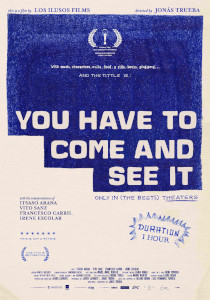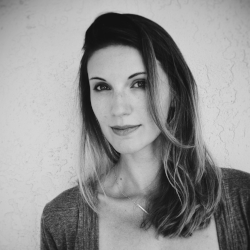Posted by Elena del Valle on June 26, 2024

You have to come and see it
Photo (and screener): Outsider Pictures
In the film You have to come and see it (Teneis que venir a verla) director and writer Jonas Trueba follows two couples in their thirties, their discussions as couples and as friends. The story begins in Madrid, where the two couples go to see a show. One couple rejoice in their new home, on the outskirts of town and close to the countryside. Then they announce that she is pregnant. Months later the other couple takes the train to visit them in their home.
The slow paced 64-minute film from 2021 is in Spanish with English subtitles. It will open in the United States as part of Outsider Pictures showcase of Latin and Spanish films that can be viewed either individually or as a group of five films screened at Cannes, San Sebastian, and Berlin.
According to promotional materials the films will screened individually in rotation each day of the week, and can be seen separately or by purchasing a pass to attend all films. This collection is scheduled to open at the Cinema Village in New York on July 19, and the Laemmle Royal in Los Angeles on July 26.
Posted by Elena del Valle on June 20, 2024

Thirst cover
Photos: Dutton, Anita Bugni
This year Dutton released Thirst (Dutton, $28), a 241-page hardcover fiction title, in English and Spanish in the United States. Written by Argentina born Marina Yuszczuk the vampire horror novel is set in early colonial Buenos Aires, Argentina. Heather Cleary translated the book. The author replied to questions by email via her publishing company publicist. The translator replied to questions via email.
When asked, with so many vampire novels already in print what inspired her to write Thirst she replied: “Well, precisely: I was inspired by thirst, which is endless. I had the desire to write about a vampire when an image materialized in my mind. I sensed I could bring a new perspective because this was a very specific image, set in Cementerio de la Recoleta in the XIXth century Buenos Aires. There are practically no vampires in the Argentinian literary tradition, and even horror is not a widely cultivated genre in my country. On another, more personal level, the urge to dive into such an erotic, sensual topic was irresistible.”
When asked about her primary target audience (in general, in the United States, and for the English edition) she replied: “First of all, I suppose, readers like myself who became fascinated with gothic literature as teenagers, who spent long hours of loneliness reading in their bedrooms with the door locked and developed a secret life, much like the heroes and heroines of gothic stories. I also believe—and this has been the case in Argentina—that Thirst is a vampire novel that can appeal to readers who are not used to reading vampire novels, or even horror. And I have to say, as I am myself a cinephile, I think this will appeal to horror movie fans, because vampire movies are in the very heart of Thirst.”
Regarding her biggest challenge in relation to the translation she said, “The biggest challenge in relation to the translation was getting editors in the US to read it, I guess! But that was my agent’s work, and she was brilliant. Then, of course, one aspect of the translation in which translator Heather Cleary and I worked very carefully was the specific scenario of XIXth century Buenos Aires with its particular mixture of colonial, French, and Italian architecture—a rather small town soon to become a modern, cosmopolitan city.”

Marina Yuszczuk
When asked about her goal and how she measures success she said: “I don’t think writers have goals other than to be able to keep on writing, and it is that necessity that makes us care about success, if we ever do. For me, success is the possibility to secure the writing of my next novel.”
Regarding next projects the author said, “I have already written two more novels after Thirst. One of them, Para que sepan que vinimos, was published in Argentina in 2022, and it’s a ghost story centered on the relationship between a grown-up daughter and her deceased mother. I just finished another novel, a gothic story set in a science museum in the last decades of the XIXth century.”
When asked “How did you decide on the cover art?” and “Who designed it?” she replied “The design team at Dutton did the cover art for the US edition, and I think it’s perfect—just the right mix of red, pink, the sensuality of the female body and the luxurious funerary art of past centuries.”
Yuszczuk, born in 1978, is founding editor of Rosa Iceberg, a press focused on publishing writing by women. She is the author of multiple books of poetry, short-story collections, and novels. She has a Ph.D. in literature from Universidad Nacional de la Plata and is a film critic for an Argentina newspaper. Thirst is her first book to be published in the United States.

Heather Cleary
“The greatest challenge, which was also one of the things I loved most about translating Thirst, was creating two distinct voices—one is sensual, gothic, and grounded in the nineteenth-century, while the other is very contemporary and more cerebral, in the sense that the character is presented through her diary entries, where she explores her inner world in detail,” said Cleary when asked what the greatest challenge the translation posed. “Marina’s Spanish provided a crystal clear model for how this should work, but rendering these tones and atmospheres with the different set of linguistic tools that English provides required careful attention.”
When asked if translating Spanish from Argentina differs from Spanish from other countries she replied, “Yes, in the sense that Spanish is different from country to country (and within countries, for that matter). But no, in the sense that the process of translation, wherever the Spanish is from, involves first understanding those differences and working with that as a baseline. For this project, it helped that I lived in Buenos Aires for nearly two years—in the same neighborhoods frequented by the characters, actually—so it was easier to distinguish between expressions that are often used colloquially and phrases that diverge from typical speech and should be treated more poetically.”
When asked if there was something she liked or that stood out in particular she replied, “I love the complexity with which Marina portrays female desire, which includes sexual desire but also so many other forms: the desire for professional success, for solitude within the responsibilities of caregiving, for connection with family and friends, and so on. This, and the textures of the relationship between the modern narrator and her dying mother (and also her relationship with her young son), make this book truly exceptional.”
Cleary’s work has been recognized by the National Book Foundation and the Mellon Foundation. She teaches at Sarah Lawrence College. She is the author of The Translator’s Visibility: Scenes from Contemporary Latin American Fiction.
Comments:
Filed Under: Books
Posted by Elena del Valle on June 7, 2024

The Haas School of Business at the University of California, Berkeley seeks a strategic and visionary leader to serve as its next Chief Marketing Officer (CMO). UC Berkeley (https://www.berkeley.edu/) is internationally renowned for excellence, for the opportunities it affords students of all backgrounds, and for pioneering achievements across all disciplines. Click to read the entire Job Ad for Chief Marketing Officer, University of California, Berkeley
Posted by Elena del Valle on June 7, 2024

Frederick Health (www.frederickhealth.org), in partnership with WittKieffer, is conducting a national search for an inaugural Vice President, Strategic Marketing and
Communications (VP). Frederick Health provides comprehensive healthcare services to the residents of Frederick County. The system includes Frederick Health Hospital, Frederick Health Medical Group, Frederick Health Employer Solutions, Frederick Health – click to read the entire Job Ad for Vice President, Strategic Marketing and Communications, Frederick Health
Posted by Elena del Valle on June 5, 2024

Why We Die
Photo: Harper Collins Publishers (William Morrow)
In Why We Die The New Science of Aging and the Quest for Immortality (William Morrow, $32.50) Venki Ramakrishnan, co-recipient of the 2009 Nobel Prize in Chemistry (for his work on the structure of the ribosome) and former president of the Royal Society, explores human mortality in a science and research oriented and thought provoking book.
In the book he asks what purpose we serve once we pass our reproductive years. Why do grandparents exist, he asks, for example. He explains that in the causes of aging known to date the processes are so interlinked and complex it’s difficult to separate causes and effects.
He wonders if living forever would be a good thing. He zeroes in on scientific research that has caught his attention from among many studies. And he presents the case that there would be social and ethical costs of attempting to live forever.
The 310-page book published in 2024 is divided into 12 chapters. Ramakrishnan leads the research team at the MRC Laboratory of Molecular Biology in Cambridge, England.
Comments:
Filed Under: Books
















